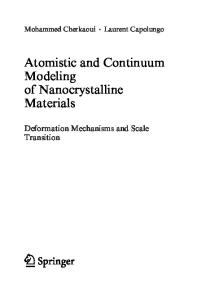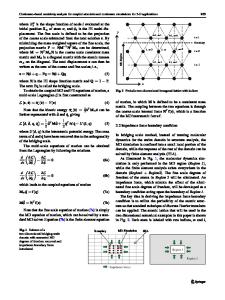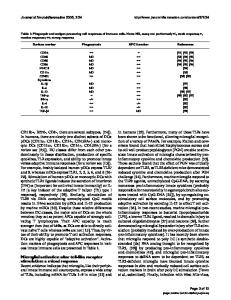From Atomistic to Continuum Descriptions of Morphological Evolution
- PDF / 134,887 Bytes
- 6 Pages / 612 x 792 pts (letter) Page_size
- 14 Downloads / 341 Views
JJ8.8.1
From Atomistic to Continuum Descriptions of Morphological Evolution Christoph A. Haselwandter and Dimitri D. Vvedensky The Blackett Laboratory, Imperial College, London, SW7 2BW, United Kingdom ABSTRACT Lattice Langevin equations are derived from the rules of lattice growth models. These provide an exact mathematical description that is suitable for direct analysis, such as the passage to the continuum limit, as well as a computational alternative to kinetic Monte Carlo simulations. This approach is applied to ballistic deposition and a model for conditional deposition, both of which yield the Kardar–Parisi– Zhang equation in the continuum limit, and a model of strain relaxation during heteroepitaxy. INTRODUCTION The morphological evolution of surfaces is often described by idealized lattice models [1, 2] whose transition rules reflect the dominant atomistic processes for a specific experimental setup. Broadly speaking, there are two standard methods for investigating such models. The first is to take the lattice model at face value and carry out a kinetic Monte Carlo (KMC) simulation. This allows detailed studies of the evolution of the microscopic surface morphology and has led to accurate descriptions of several growth experiments [3–5]. The second method is based on the analysis of a continuum equation for the system at coarse-grained length and time scales. Prominent examples are the Edwards–Wilkinson [6], Kardar–Parisi–Zhang [7], and the Villain–Lai–Das Sarma equations [8, 9]. KMC simulations and continuum equations have led to many insights, but neither method is without inherent drawbacks. KMC simulations do not discriminate between different stochastic processes, such as surface diffusion and deposition [10], and even a small modification of the transition rules necessitates repeating an entire set of simulations. Moreover, predictions made from KMC simulations are valid only over the time scales and system sizes that are accessible with the available computing resources. Continuum equations, on the other hand, are usually asserted on the basis of phenomenological or symmetry arguments [8, 9], pre-empting a direct connection between their coefficients and specific atomistic processes. Thus, it is not always clear how a change in the growth conditions affects the continuum equation nor how, or even whether, the early stages of growth can be described. In this paper, we address these issues by outlining a method for deriving exact lattice Langevin equations and asymptotically exact continuum equations directly from transition rules on a lattice. The lattice Langevin equation provides a computational alternative to KMC simulations and a starting point for further analysis. The associated continuum equation is then obtained with renormalization group methods applied to the smoothed lattice model. This procedure determines the atomistic ancestry of the various coefficients. We illustrate these ideas with applications to several growth models and with the derivation of a continuum equation for a model of strain
Data Loading...










